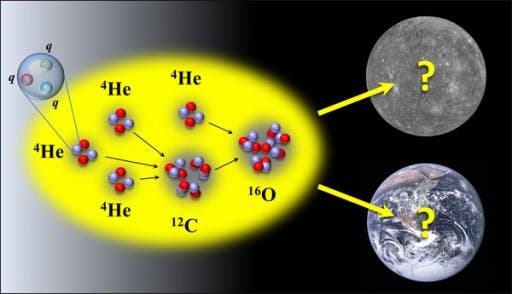
Light quark mass determines carbon and oxygen production and the viability of carbon-based life. Image credit: Dean Lee. Earth and Mercury images from NASA.
All life as we know it is primarily based on two elements: carbon and oxygen. Scientists at North Carolina State University investigating the conditions required for the formation of these life essential ingredients found that the Universe lives little room for error.
Carbon and oxygen are formed as combustion byproducts after helium burns inside a giant red star. However, for Carbon-12 to form – an essential carbon isotope we’re all made of – specific conditions need to be facilitated. Carbon-12 can only form when alpha particles (helium-4 nuclei) combine in a specific manner – to be more precise, carbon-12 needs to be under an excited state known as the Hoyle state. Similarly, Oxygen is produced by the combination of another alpha particle and carbon.
NC State physicists worked off previous research that confirmed both the existence and structure of the Hoyle state with a numerical lattice, which formed the basis for simulations of proton-neutron interactions. Protons and neutrons consist of elementary particles known as quarks. A fundamental property of these elementary particles is the light quark mass, which affects the particles’ energies. The Hoyle state has a very specific energy – measured at 379 keV (or 379,000 electron volts) above the energy of three alpha particles.
The physicists ran a new lattice calculation using massive computing power at the Juelich Supercomputer Centre and found that a tiny variation of the light quark mass will dramatically alter the Hoyle state energy in such a manner that carbon and oxygen would not be produced. So, in a way, the Universe has a very tight hold on how life may form.
“The Hoyle state of carbon is key,” NC State physicist Dean Le says. “If the Hoyle state energy was at 479 keV or more above the three alpha particles, then the amount of carbon produced would be too low for carbon-based life.
“The same holds true for oxygen,” he adds. “If the Hoyle state energy were instead within 279 keV of the three alphas, then there would be plenty of carbon. But the stars would burn their helium into carbon much earlier in their life cycle. As a consequence, the stars would not be hot enough to produce sufficient oxygen for life. In our lattice simulations, we find that more than a 2 or 3 percent change in the light quark mass would lead to problems with the abundance of either carbon or oxygen in the universe.”
The findings were reported in a paper published in the journal Nuclear Theory.









